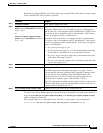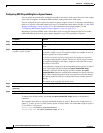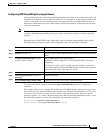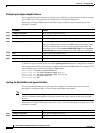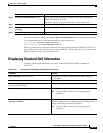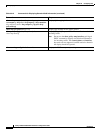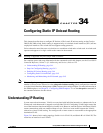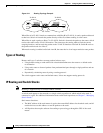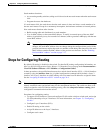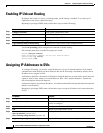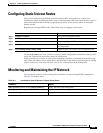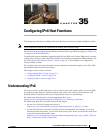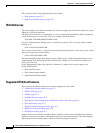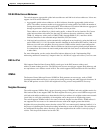
34-3
Catalyst 2960 and 2960-S Switch Software Configuration Guide
OL-8603-09
Chapter 34 Configuring Static IP Unicast Routing
Steps for Configuring Routing
Stack members functions:
• Act as routing standby switches, taking over if elected as the new stack master when the stack master
fails.
• Program the routes into hardware.
If a stack master fails, the stack detects that the stack master is down and elects a stack member to be
the new stack master. Except for a momentary interruption, the hardware continues to forward packets.
New stack master functions after election:
• Builds routing table and distributes it to stack members.
• Uses its MAC address as the router MAC address. To notify its network peers of the new MAC
address, it periodically (every few seconds for 5 minutes) sends a gratuitous ARP reply with the new
router MAC address.
Note If you configure the persistent MAC address feature on the stack and the stack master
changes, the stack MAC address does not change during the configured time period. If the
previous stack master rejoins the stack as a member switch during that time period, the stack
MAC address remains the MAC address of the previous stack master. See the “Enabling
Persistent MAC Address” section on page 7-17.
Steps for Configuring Routing
By default, IP routing is disabled on the switch. For detailed IP routing configuration information, see
the Cisco IOS IP Configuration Guide, Release 12.2 from the Cisco.com page under Documentation >
Cisco IOS Software Releases > 12.2 Mainline > Configuration Guides.
In these procedures, the specified interface must be a switch virtual interface (SVI)—a VLAN interface
created by using the interface vlan vlan_id global configuration command and by default a Layer 3
interface. All Layer 3 interfaces on which routing will occur must have IP addresses assigned to them.
See the “Assigning IP Addresses to SVIs” section on page 34-4.
Note The switch supports 16 static routes (including user-configured routes and the default route) and any
directly connected routes and default routes for the management interface. The switch can have an IP
address assigned to each SVI. Before enabling routing, enter the sdm prefer lanbase-routing global
configuration command and reload the switch.
Procedures for configuring routing:
• To support VLAN interfaces, create and configure VLANs on the switch or switch stack, and assign
VLAN membership to Layer 2 interfaces. For more information, see Chapter 13, “Configuring
VLANs.”
• Configure Layer 3 interfaces (SVIs).
• Enable IP routing on the switch.
• Assign IP addresses to the Layer 3 interfaces.
• Configure static routes



